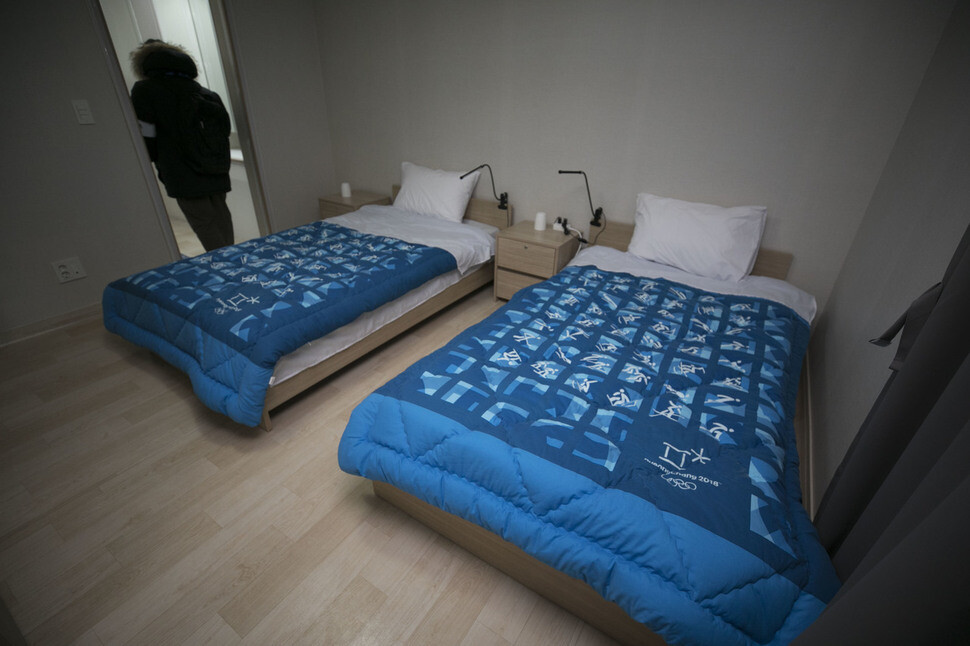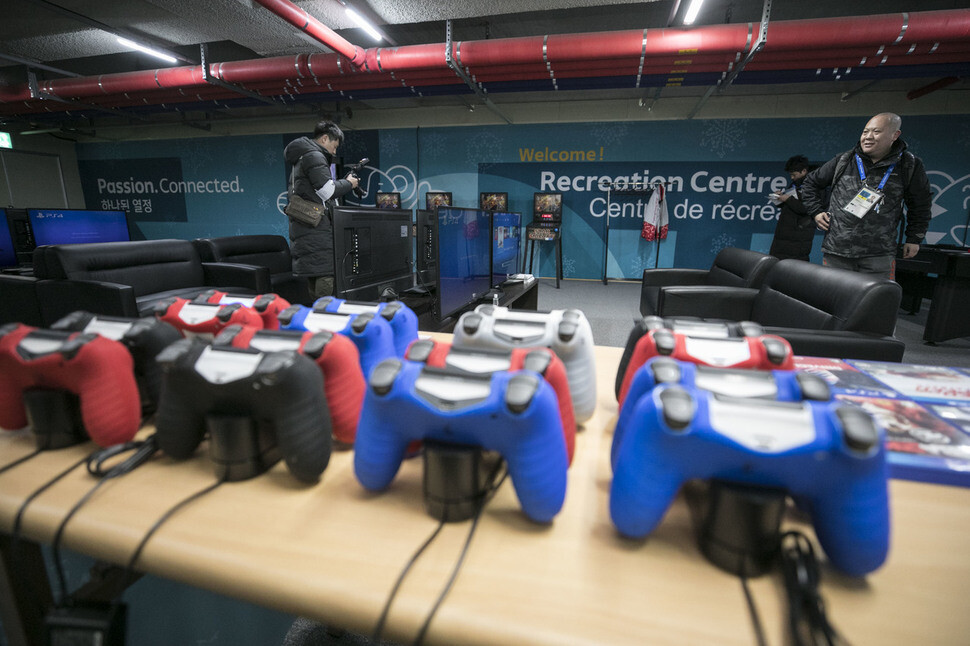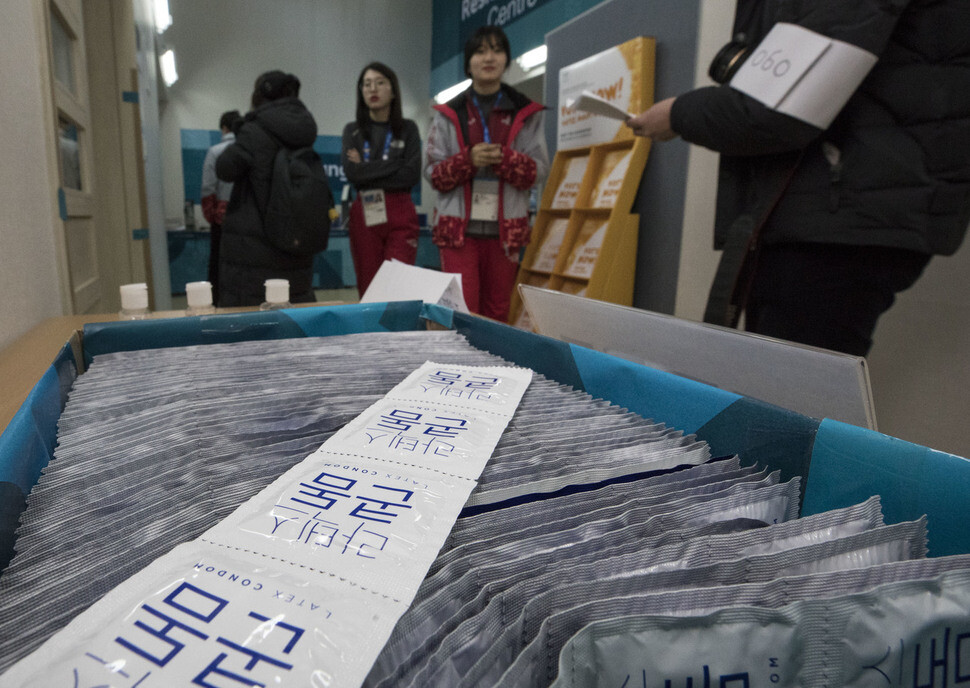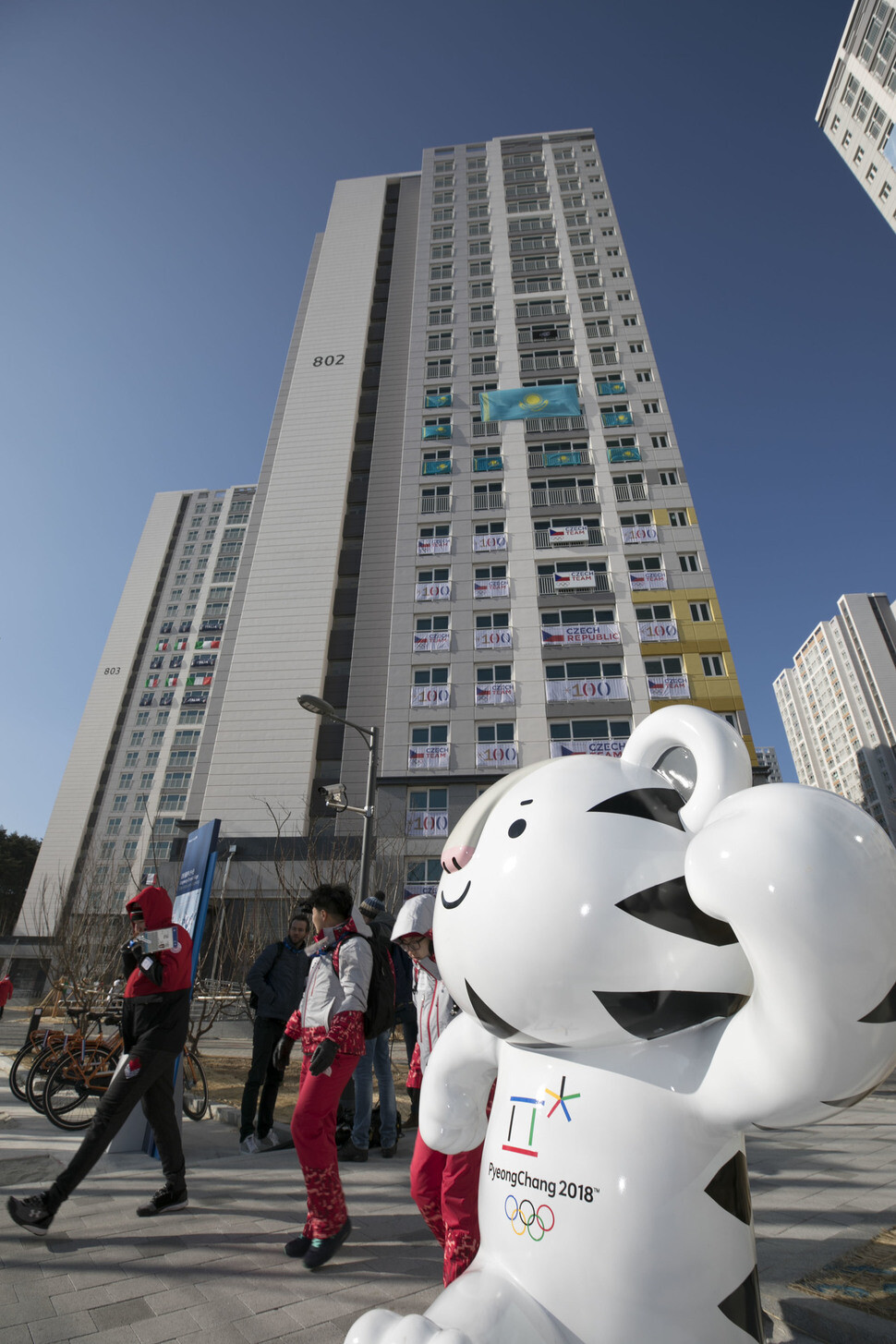hankyoreh
Links to other country sites 다른 나라 사이트 링크
A reporter’s in-depth look at the Pyeongchang Winter Olympic Athletes’ Villages

“It makes me happy when someone tells me, ‘The food was delicious.’” Kim Gi-hoon, director of the Gangneung Olympic Athletes’ Village for the 2018 Pyeongchang Winter Olympics, has frequently encountered the 46 members of the North Korean squad – including 22 women’s hockey players and other athletes along with 24 officials – since they finished moving in on Feb. 5. Often, they meet at the restaurant. Kim said he was gratified when told that the visitors had enjoyed their meals. The two athletes’ villages in Gangneung and Pyeongchang accommodate 5,300 to 5,400 squad members from 92 countries.

Capable of housing around 2,200, the village in Gangneung is used mainly by athletes competing in ice sports. North Korea is also using apartments in a building numbered 804 as accommodations for its athletes in snow sports such as Alpine and cross-country skiing. The newly built apartments have large living rooms and three rooms with five total beds. The lighting and showers add to the cozy atmosphere.
“We’re very happy with the overall environment provided by Pyeongchang. The weather isn’t even that cold for us,” said Lars Otto Bjørnland, media spokesperson for Team Norway, at the village’s recreation center.
“The North Korean athletes are using the same building as us, and we exchange smiles and greetings whenever we meet them,” he added.

Another glimpse at the North Korean athletes was shared by staff members at the restaurant, a temporary structure built in front of the village. “For the first two days, [the athletes] mainly came looking for Korean food. Since then, they’ve often been eating at the salad and foreigners’ sections, and they like the spaghetti and pizza,” a chef in the Korean food section said.
Director Kim explained, “Our goal is to provide a comfortable environment for the North Korean athletes and athletes all around the world that’s like resting at home while they’re competing.”
“We’re doing our best to convey the characteristic warmth of Koreans,” he said.

The situation is similar at the Pyeongchang village, which is built to accommodate around 3,200 athletes competing in snow sports. The director there, Yoo Seung-min, said the “priority is on allowing the athletes to eat well and spent their time in warmth.” The Pyeongchang village’s restaurant alone has 180 chefs, 40 patissiers, and 15 nutritionists on staff providing 420 different dishes. Halal meals and other dishes are also available to meet religious dietary requirements. Athletes eat for free, while team officials have to purchase a 30,000 won (US$27.70) ticket.
“Not all of the athletes have arrived the village yet, and the event hasn’t started, so it’s been pretty steady around the clock, without any times when it’s especially crowded,” a Pyeongchang Olympics Organizing Committee official said.

Prayer rooms for different religions are also set up in the villages, along with recreation centers where the athletes can enjoy massages and games. Particularly popular among the athletes are the health clubs, where they can do aerobic exercise and weight training.
“The North Korean athletes usually come in in the morning and do low-intensity training for about two hours,” said a health club volunteer at the Gangneung athletes’ village. “The North Korean players and most of the other athletes all have really developed thighs.”

Polyclinics are also set up to provide medical services. In addition to orthopedics, pain medicine, physical therapy, and other general medical services, the Pyeongchang village also provides Oriental medicine and acupuncture treatment.
“There are 30 physicians, with nurses assigned to different treatment divisions,” explained Kim Jeong-a, head of the nursing department for the Pyeongchang village’s polyclinic.
“We have three physicians on standby around the clock for the most essential areas in the athletes’ village, namely trauma, emergency medicine, and orthopedics,” she said.
Specialists are also on standby to provide psychological counseling and psychiatric services for athletes. Specialized psychological counseling is available at all times as needed by athletes.
By Kim Chang-keum and Lee Chan-young, staff reporters
Please direct questions or comments to [english@hani.co.kr]

Editorial・opinion
![[Editorial] Yoon must halt procurement of SM-3 interceptor missiles [Editorial] Yoon must halt procurement of SM-3 interceptor missiles](https://flexible.img.hani.co.kr/flexible/normal/500/300/imgdb/child/2024/0501/17145495551605_1717145495195344.jpg) [Editorial] Yoon must halt procurement of SM-3 interceptor missiles
[Editorial] Yoon must halt procurement of SM-3 interceptor missiles![[Guest essay] Maybe Korea’s rapid population decline is an opportunity, not a crisis [Guest essay] Maybe Korea’s rapid population decline is an opportunity, not a crisis](https://flexible.img.hani.co.kr/flexible/normal/500/300/imgdb/original/2024/0430/9417144634983596.jpg) [Guest essay] Maybe Korea’s rapid population decline is an opportunity, not a crisis
[Guest essay] Maybe Korea’s rapid population decline is an opportunity, not a crisis- [Column] Can Yoon steer diplomacy with Russia, China back on track?
- [Column] Season 2 of special prosecutor probe may be coming to Korea soon
- [Column] Park Geun-hye déjà vu in Yoon Suk-yeol
- [Editorial] New weight of N. Korea’s nuclear threats makes dialogue all the more urgent
- [Guest essay] The real reason Korea’s new right wants to dub Rhee a founding father
- [Column] ‘Choson’: Is it time we start referring to N. Korea in its own terms?
- [Editorial] Japan’s rewriting of history with Korea has gone too far
- [Column] The president’s questionable capacity for dialogue
Most viewed articles
- 1Months and months of overdue wages are pushing migrant workers in Korea into debt
- 2At heart of West’s handwringing over Chinese ‘overcapacity,’ a battle to lead key future industries
- 3Seoul getting its first-ever vertical farm
- 4Fruitless Yoon-Lee summit inflames partisan tensions in Korea
- 5Trump asks why US would defend Korea, hints at hiking Seoul’s defense cost burden
- 6[Editorial] Yoon must halt procurement of SM-3 interceptor missiles
- 7[Editorial] New weight of N. Korea’s nuclear threats makes dialogue all the more urgent
- 8Dermatology, plastic surgery drove record medical tourism to Korea in 2023
- 9Under conservative chief, Korea’s TRC brands teenage wartime massacre victims as traitors
- 10Gangnam murderer says he killed “because women have always ignored me”